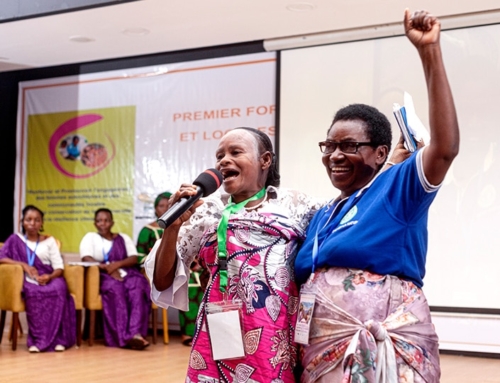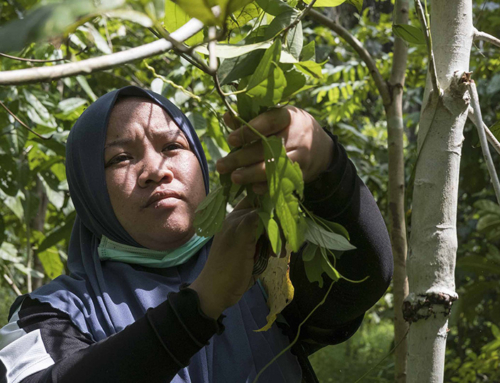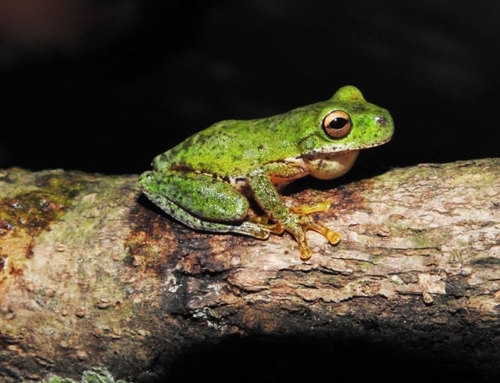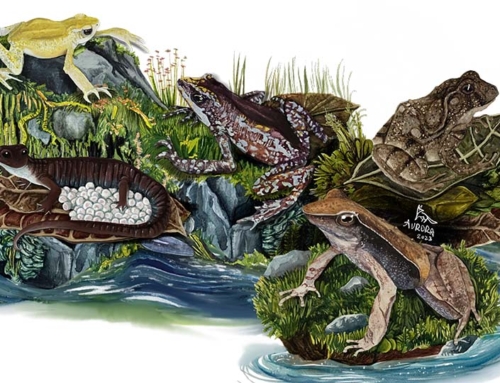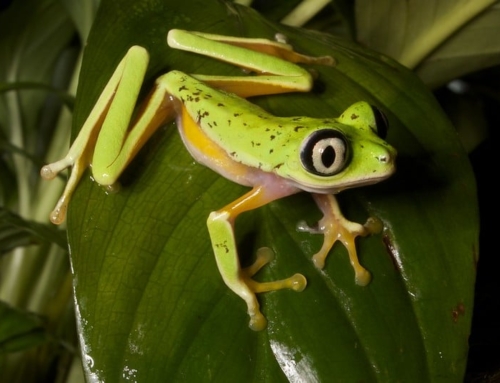Amphibians occupy a complex place in cultures around the world. Throughout history, these vibrant, shape-shifting creatures of land and water have been met with both wonder and hostility.
In the second part of this new series Amphibians and Culture, Amphibian Programme officer Pria Ghosh discusses the cultural role of amphibians in Central and South America. Here, many Indigenous communities nurture these species and their ecosystems, within relationships built on respect and reciprocity.
In the highlands of Central and South America, many communities view amphibians as harbingers of the harvest and times of plenty. In Colombia’s Sierra Nevada mountains, our partner Fundación Atelopus is working with the Indigenous Arhuacos community to save the starry-night harlequin toad, or ‘Gouna’ in the Arhuacos language.
Scientists had considered the starry-night harlequin extinct for nearly 40 years. Then, in 2016, the Arhuacos revealed that the toads were alive and thriving in their territory. The community, who had always lived in harmony with the species, and who consider it sacred, had spent the past decades protecting it and its habitat from harm.
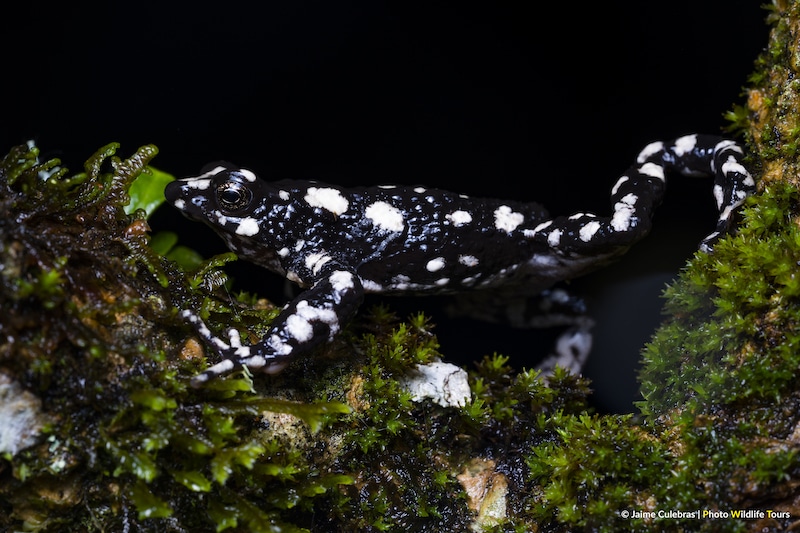
The starry-night harlequin toad gets its name for its bright white spots, spangled on coal black skin. For nearly forty years, scientists believed it was extinct. Image: © Jaime Culebras.
How Indigenous knowledge saved the starry-night harlequin
The rhythm of the toads’ lives set the beat of the Arhuacos calendar and indicates traditional agricultural cues. When they emerge with the rains, it’s time to plant, and when they disappear it’s time to harvest.
Kaneymaku Suárex Chaparro, a member of the Arhuacos Sogrome community and a biology student at the Francisco José de Caldas District University, explains “The Sierra Nevada de Santa Marta [the toad’s home mountain range] is a place that we consider sacred, and harlequin frogs are the guardians of water and symbols of fertility… The community manages its resources to the extent that they preserve their home, as dictated by their law of origin, which means that they live in balance with Mother Earth.”
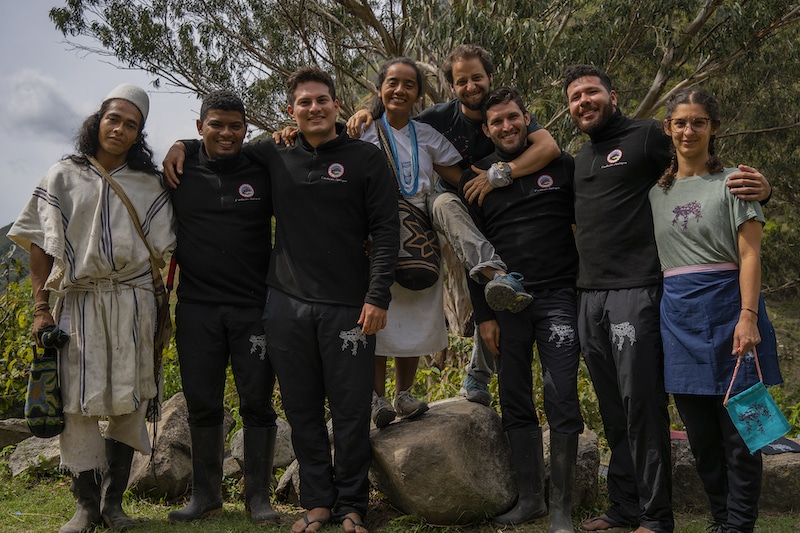
Members of the Arhuaco people and Fundacion Ateloupos are working together to continue protecting the starry-night harlequin. Image: © Fundación Atelopus.
Today, the Arhuacos are collaborating with Synchronicity Earth partner Fundación Atelopus combining scientific and Indigenous knowledge to monitor the population of the starry night harlequin, while keeping the sacred toad’s exact location a secret . (Secrecy maintains community sovereignty while preventing the toad from becoming a tourist attraction or target for the pet trade). Through this research, they hope to learn which elements of the Arhuacos approach have saved the toads from extinction, enabling them to protect the species in perpetuity, together.
Amphibians and culture in the Bolivian and Peruvian Andes
In the Quechua and Aymara cultures of the Bolivian and Peruvian Andes, ‘Pachamama,’ or Mother Earth, is the highest deity. In Bolivia, Pachamama is represented by the ‘jamp’atu’ (toad). Similar to the role of toads in Arhuaco culture, this spiritual association is closely tied to agriculture and the patterns of the seasons. In the Andes, farmers say that the spirit of Pachamama is in the jamp’atus that appear at the start of the rains, where they care for the fields and bring good luck.
Two of our Andean partners—Bolivian Amphibian Initiative (BAI) and Asociación Pro Fauna Silvestre—Ayacucho—are using the close ties between amphibians and culture to simultaneously revive biological and cultural diversity.
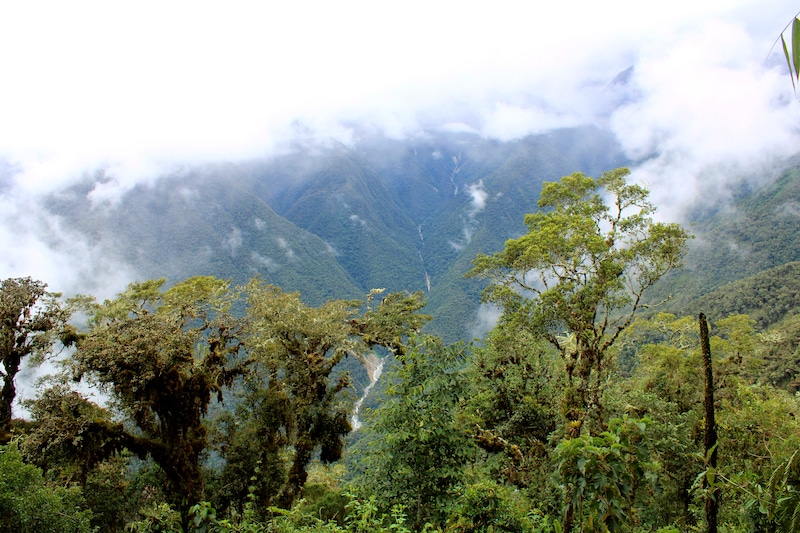
The humid, biodiverse forests of the Andes mountains lend themselves to a rich variety of amphibian life. Image: © Vladimir Diaz.
In Peru, the role of amphibians in human cultures can be dated back to pre-Inca times. The Quechuan names for some species are still used today. Rhinella spinulosa, known in English as the warty toad, is called ‘hanpatu’ in Quechua. Their tadpoles are ‘ultu’, and their eggs are ‘uqullu’ or ‘llami’. The lake titicaca water frog is called ‘karya’ or ‘kayra’.
Asociación Pro Fauna Silvestre researches the biodiversity of the Peruvian Andes, with a focus on monitoring critical habitats over the long term, while carrying out conservation awareness campaigns locally. They also record Quechuan names for local amphibians and reptiles, preserving traditional ecological knowledge about them.
BAI is working to create a sanctuary for the Lake Titicaca water frog, which holds huge importance in local culture. In times of drought, many communities make offerings to the Apus, the spirits of the high mountains. Frog song is a sign that the offerings have been accepted, and the rains will come. Others hold ritualised ‘water fights’ for Pachamama, and then wait for frog song to announce that rain is on its way.
Patricia Mendoza, BAI’s Executive Director, explains that the close association between Pachamama and jamp’atu has been of huge help to their work in the Andean region, where rural people maintain a strong connection to an Andean cosmovision and natural world.
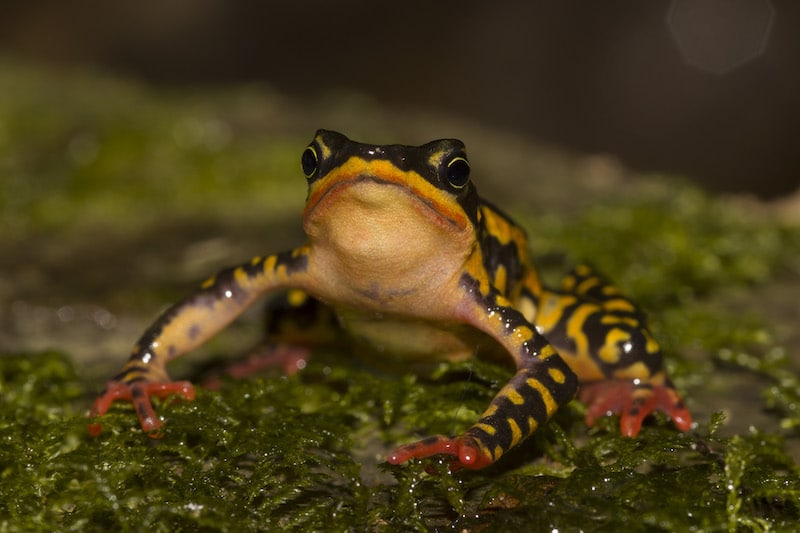
The stunning Atelopus Tricolour is just one of the incredible species protected by Bolivian Amphibian Initiative. Image: © Cabriel Callapa
However, BAI has also noticed that in urban areas amphibians have become associated with witchcraft and are increasingly feared— – the relationship with nature and Pachamama is being lost. Therefore, a key part of their work is reviving and strengthening Bolivian culture alongside conservation.
Diverging perceptions of amphibians in Mexico and Brazil
Meanwhile, in Mexico, Synchronicity Earth’s new partner Conservación de Anfibios is working to save the country’s stunning diversity of native salamanders. Here, similarly to the ancient cultural associations of salamanders in Europe, there are very polarised views of amphibians.
On the one hand, Mexico is home to perhaps the most famous salamander of all – that social media stalwart, the axolotl. In a strange twist of nature’s magic, the axolotl spends its whole life in juvenile form. For the Aztecs, these creatures were the animal form of Xolotl, the god of death who guided human souls to the underworld and was the brother of Quetzacoatl, the Aztec patron god of learning and knowledge.
On the other hand, in Cuetzalan, where Conservación de Anfibios is working, there are local beliefs that amphibians are dangerous— that they can suck the breastmilk of pregnant women or even get women pregnant, and that the touch of a toad’s urine will burn your skin.
Conservación de Anfibios is establishing a sanctuary for threatened salamanders in Mexico’s cloud forests, and alongside this is developing educational activities to show people a different way of viewing amphibians so that these very vulnerable species can be protected.
In Brazil, Synchronicity Earth’s advisor, Luis Marin da Fonte, and amphibian conservationist Bela Barata—the leader of Instituto Biotrópicos’s Amphibian Programme— also report on this divergent view of amphibians depending on demography.
Among Indigenous Peoples and particularly Indigenous Peoples of the Amazon, amphibians are seen as symbols of luck and prosperity, and compounds from their skin are used in traditional medicine. Outside of these cultures, amphibians are largely viewed negatively and with great suspicion. Bela is seeking to address these views through environmental education programmes, showing school children the beautiful diversity of the group.
This increasingly polarised view of amphibians is repeated across the world. For example, in some parts of South Africa and India, younger generations are losing their positive associations with amphibians—and our partners there, like our partners in South and Central America, are working to return these stories to the public consciousness.
This blog was made possible by the insights, stories, and edits shared by our partners Fundación Atelopus, Bolivian Amphibian Initiative, Asociación Pro Fauna Silvestre—Ayacucho, Conservación de Anfibios and Instituto Biotrópicos.

